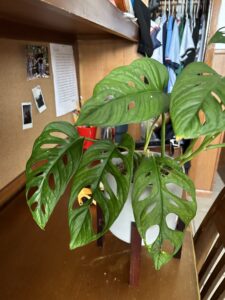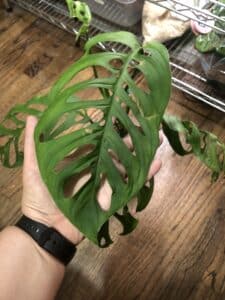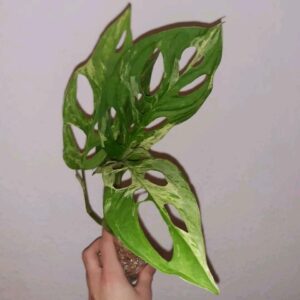It’s no surprise that the Monstera, often known as the “Swiss Cheese Plant,” has grown famous due to its enormous, bright leaves and unusual pattern.
The distinctive leaf design of Monstera esqueleto and Monstera adansonii has been increasingly popular in recent years for aesthetic home decor.
Although both the species share many similarities, it is crucial to identify the differences to identify the plants!
Monstera esqueleto has large and light green colored leaves with a more leathery texture. On the other hand, Monstera adansonii has comparatively smaller leaves with rich green colored leaves with a less leathery texture. They also differ in growth rate and fenestration patterns.

Some of the primary differences can help you identify the species of Monstera. With the difference in species, the care required for both species also varies.
Therefore, having a quick scan of this article can help you with the differences between the Monstera esqueleto and adansonii and learn about their care requirements.
Table of Contents
Are Monstera Esqueleto and Monstera Adansonii Same?
The answer is No.
Despite some of the characteristics being the same, Monstera esqueleto and Monstera adansonii are different!
The size and the color, as well as the fenestration pattern and the texture, distinguish Monstera esqueleto from Monstera adansonii.
The Monstera esqueleto and adansonii belong to the same Family, Araceae, known for broad evergreen leaves.
However, for both plants, the significant difference lies in their leaves, fenestration, and texture.
It can be difficult to note these plants’ differences merely by looking at them because they both look similar physically yet are entirely different species.
The table below compares Monstera esqueleto and Monstera adansonii in general.
| Characteristics | Monstera esqueleto | Monstera adansonii |
|---|---|---|
| Plant Type | Epiphytic Perennial | Epiphytic Perennial |
| Other Names | Monstera epipremnoides | Swiss cheese plant |
| Order | Alismatales | Alismatales |
| Family | Araceae | Araceae |
| Genus | Monstera | Monstera |
| Species | epipremnoides 'Esqueleto' | adansonii |
| Toxicity | Toxic to cats and dogs | Toxic to cats and dogs |
| Native | Originated in Costa Rica's cloud forests | Originated in Central and South America, regions of southern Mexico and the Caribbean |
| USDA Growth Zones | 9b -11 | 10b to 12 |
Monstera Esqueleto Vs. Adansonii [Confusion Solved!]
As you know, the species of Monstera shows only slight differences. Some tips for identifying their differences can come in handy.
The key distinctions between Monstera esqueleto and adansonii are outlined below.
| Characteristics | Monstera esqueleto | Monstera adansonii |
|---|---|---|
| Leaf Color | Has lighter green color. | Has dark rich green color. |
| Leaf Texture | More leathery than anansonii. | Less leathery than esqueleto. |
| Size | Leaves can grow up to 2 feet long. | Leaves can grow about 4-6 inches long. |
| Flower | Flowering is rare. | Yellowish white flowers can be seen. |
| Fenestration Pattern | Fenestrated leaves with larger incisions. Pattern has a pinnatifid appearance. | Leaves with a fenestrated pattern of tiny holes. Pattern has flattened circle or ellipse appearance. |
| Growth Habit | Vines have less trailing pattern comparatively. | Vines have more trailing pattern. |
| Price | Expensive can range from 100$ to 500$ | Cheaper starting from 10$ to 40$ |
1. Difference in Origin
Monstera esqueleto is a plant that grows in the tropics. It’s thought to have originated in Costa Rica’s cloud forests, which have plenty of rain, humidity, and warm temperatures.
On the other hand, Monstera adansonii can be found in Central and South America and regions of southern Mexico and the Caribbean.

Learning about the Monstera origin, you may wonder how and when you can propagate Monstera? Read on: How to Propagate Monstera Adansonii?
2. Leaf Color
Monstera esqueleto and adansonii have almost the same leaves in terms of shape. However, the fenestration pattern differs.
Monstera esqueleto has big leaves with lighter green color than adansonii leaves.
The leaves of Monstera adansonii are a rich and dark shade of green. Monstera esqueleto has leaves that are a lighter shade of green with a yellowish tint.
Despite this, the plant’s foliage is much more shiny and glossy, and it will still look lovely at home.
3. Leaf Shape and Texture
Although both species have many similarities, leaf texture is not one of them.
Esqueleto leaves have a leathery texture. On the other hand, adansonii has smoother leaves.
Monstera adansonii has oval Shaped leaves, or sometimes the leaves are called heart-shaped too.
Similarly, Monstera esqueleto also has almost the same shape, but the texture is leathery than adansonii.

Like many other houseplants, Monstera has many benefits. Read on: 8 Monstera Plant Benefits
4. Plant’s Size
Monstera adansonii leaves are about 4-6 inches long when grown indoors, but mature leaves can grow up to 20-30 inches long when planted on a trellis with plenty of areas.
On the other hand, Monstera esqueleto has more giant leaves and can develop up to 2 feet long vines.

Even so, distinguishing the two when they’re young can be challenging.
Not only do these large leaves enhance the appearance of the plants, but they also use these perforations to cope with climatic extremes like rainfall and high wind, knowing that Monstera originated in the rainforest.
5. Flower Difference
The flowering of Monstera esqueleto is rare. They can bloom in their natural origin environment but not indoors.
However, if you see yellowish-white flowers in Monstera, then it’s Monstera adansonii. The flower, under the right environment, turns into edible fruit.
Since the fruit is edible, you can have a banana or pineapple-like taste when eaten.
6. Fenestration Pattern
Monstera is famous for its fenestration pattern on its leaves, which differ slightly among different species.
These patterns are so detailed and perfect that it gives the vibe of someone slicing them with skilled hands.
Even though fenestration is present in all Monstera varieties, there are considerable variances between them so that you can spot the difference.
Green fenestrated leaves with larger incisions are present in Monstera esqueleto. The size of holes varies while the fenestration pattern remains the same.
Perforations are present in both of these varieties, but the Monstera esqueletos are larger and more abundant. The holes extend from the leaf’s center to its tip.

On the other hand, leaves with a fenestrated pattern of tiny holes characterize Monstera adansonii.
The holes in the adansonii are smaller and thinner, commonly shaped like an ellipse or a narrow circle. The perforations are frequently small and undivided.
The size and shape of these holes vary, but they commonly appear as a flattened circle or ellipse.

Monstera esqueleto often has broken or incomplete leaves. The pattern exhibits a pinnatifid appearance.
Quick Tip: To keep your Monstera’s fenestrations protected from pest attacks, you can use anti-pest sprays.
7. Growth Rate
Both the Monstera esqueleto and adansonii belong to the same family, and although both Monstera species have a vining growth pattern, adansonii has a more trailing habit.
Gardeners and plant parents who are crazy about the hanging look mostly own Monstera adansonii because it gives more vines in a short time.
It is often identified as the aggressive Viner in the Monstera family. It can reach a height of 2 feet every year. From April through early October, it grows the fastest.
Allowing it to climb will cause it to develop increasingly larger leaves and expand until it reaches the end of its support.
On the other hand, Monstera esqueleto is a hemiepiphyte.It is a ground creeper in its juvenile stage and an epiphyte as an adult.
It also receives mostly dappled light due to its location under tall tree canopies. The Monstera esqueleto is a medium grower.
Therefore, Monstera adansonii is more common for the vine decor than Monstera esqueleto because of its drooping vines hanging down the basket.
WARNING! ASPCA has listed Monstera esqueleto and adansonii in a mildly toxic list. Both of these species are toxic to cats, dogs, and even children.
Similarities Between Monstera Esqueleto And Monstera Adansonii
Belonging to the same Family, both Monstera esqueleto and adansonii have many similarities.
Here are some of the structural similarities between Monstera esqueleto and adansonii.
1. Petiole
The look and texture of the petiole of Monstera esqueleto and adansonii are identical.
The petiole is the portion of the plant between the stem and the leaf. Both Monsteras have long and slender petiole with a spherical shape.
2. Stem Structure
The stem of both the Monstera esqueleto and adansonii are similar in structure and color.
They have a strong, thick, and green-colored stem that grows as much as the plant grows.
The entire plant grows from a single long stem, or vine, that generates aerial roots constantly looking for support to anchor.
3. Root System
One of the peculiar characteristics of both Monstera esqueleto and adansonii is they both have aerial roots.
The roots are often called adventitious roots and help the plant climb and sustain in a harsh environment.
Different Care Requirements of Monstera Esqueleto and Monstera Adansonii
Being a fond plant parent, you must know the different care requirements if you own more than one species of Monstera.
Once you know the care requirements of each plant, you can grow them healthy, subsiding the complications.
Here is a table that gives you all the information on the primary care requirements so you can grow your plant healthy and happy!
| Care Requirement | Monstera esqueleto | Monstera adansonii |
|---|---|---|
| Sunlight | 6-8 hours of filtered sunlight. Thrives if the plant is kept near the window. | 3-4 hours morning sun or 4-6 hours daylight. Grows well in bright indirect diffused light. |
| Soil | Requires moderate, sandy loams, well-aerated soil with a pH of 5.5 to 7. | Requires organic rich well-aerated soil with a pH of 6 to 7. |
| Temperature | Thrives in temperatures from 70-80 degrees Fahrenheit. | Ideal temperature is between 60 to 80 degrees Fahrenheit. |
| Water | Water once the top 2 inches of potting mix dries out. | Water once the top 2 inches of potting mix dries out. |
| Humidity | Household humidity above 50%. | Household humidity above 50%. |
| Fertilization | Feed with gentle liquid fertilizer with a 5-2-3 NPK ratio during the spring and summer. Cut off fertilization in winter. | Regular liquid fertilizer can be used or Feed with gentle liquid fertilizer with a 5-2-3 NPK ratio in summer and spring. Cut off fertilization in winter. |
| Pruning | Trim dead leaves and stems | Trim dead leaves and stems |
| Repotting | Once every 2 years | Once every 2 years |
Are your Monstera adansonii leaves getting yellow? Read our blog to fix yellowing Monstera adansonii leaves.
Also watch,
Conclusion
Both Monstera esqueleto and adansonii are relatively low-maintenance plant that prefers consistent indoor temperatures, indirect light, and a humid atmosphere.
Therefore, learning the differences and care requirements, any of the Monstera could be the plant for you even if you don’t have a green thumb.
We hope our Monstera esqueleto vs. adansonii helps you guide your planting journey.
Happy Planting!
